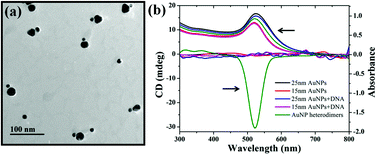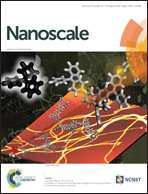A self-assembled chiral-aptasensor for ATP activity detection†
Abstract
Circular dichroism (CD) has allowed the construction of various chiral nanomaterials for different applications, including biosensing. However, the determination of a simple target-specific, economical, and biocompatible platform using CD with intracellular detection and in situ molecular probing is still required. Here, we show that a DNA zip-fastener structure self-assembled chiral-aptasensor based on gold nanoparticle heterodimers provided an outstanding capability to quantify adenosine-5′-triphosphate (ATP) by addition. The conjugation of two ATP molecules to an adenosine aptamer allowed the formation of a stable ring structure, which formed an ATP-ring adhesive scaffold upon interaction with DNA complementary sequences linked with large gold nanoparticles, the latter were able to drop and result in a decrease in CD signal. We also showed that these low-cytotoxicity and polyethylene glycol (PEG)-steady nanoconjugates were also a one-step incubation technique for the quantification and monitoring of ATP in living cells modified by cell penetrating peptides (TAT) or Cy5. The results showed that the linear intracellular detection range was from 1.5 to 4.2 mM with a limit of detection (LOD) of 0.2 mM. Our findings suggest that this chiroplasmonic sensor is a promising approach for investigating biogenic biomolecules inside cells and living organisms and for assessing their biological activity.



 Please wait while we load your content...
Please wait while we load your content...